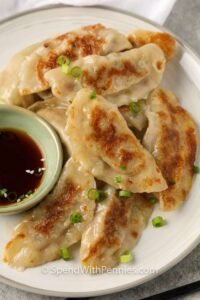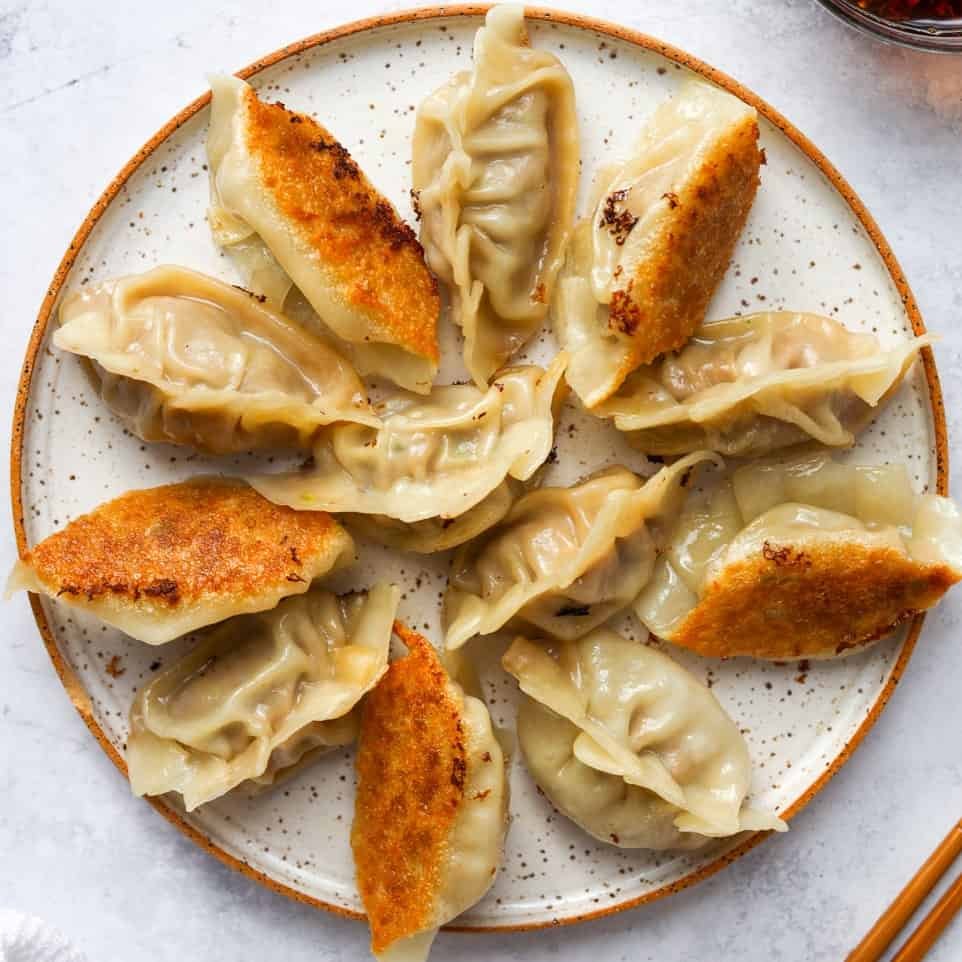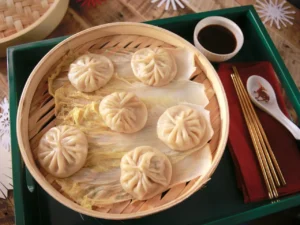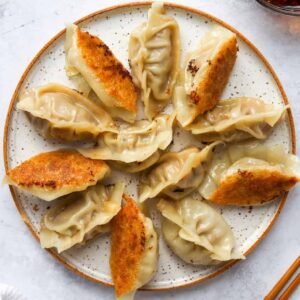Pork Dumplings: A Culinary Journey Through Flavor, Tradition, and Technique
Table of Contents
- Introduction: The Allure of Pork Dumplings
- A Brief History of Dumplings: From Ancient Origins to Global Fame
- The Anatomy of a Perfect Pork Dumpling
- The Filling: Ingredients and Techniques
- The Wrapper: Crafting the Perfect Dough
- The Cooking Methods: Steamed, Fried, and Boiled
- Regional Variations of Pork Dumplings
- Chinese Dumplings (Jiaozi, Xiaolongbao)
- Japanese Gyoza
- Korean Mandu
- Eastern European Pierogi
- Other Global Interpretations
- The Art of Making Pork Dumplings: Step-by-Step Guide
- Preparing the Filling
- Making the Wrapper
- Folding Techniques
- Cooking Methods
- Sauces and Accompaniments: Elevating the Dumpling Experience
- The Cultural Significance of Pork Dumplings
- Dumplings in Festivals and Celebrations
- Symbolism and Tradition
- Modern Innovations: Fusion Dumplings and Contemporary Trends
- Health and Nutrition: Balancing Flavor and Wellness
- Conclusion: The Timeless Appeal of Pork Dumplings
1. Introduction: The Allure of Pork Dumplings
In the tantalizing tapestry of culinary creations, dumplings stand out as delectable morsels, a testament to the ingenuity of cuisines worldwide. Among this delectable fraternity, pork dumplings reign supreme, their savory essence captivating taste buds and igniting culinary adventures. Whether steamed to delicate perfection, fried to a golden crisp, or boiled in a rich broth, pork dumplings offer a symphony of flavors and textures that transcend cultural boundaries.
Pork dumplings are more than just a dish; they are a celebration of tradition, craftsmanship, and community. From the bustling streets of Beijing to the cozy kitchens of Eastern Europe, these bite-sized delights have carved a niche in the hearts of food lovers everywhere. This article delves into the rich history, diverse variations, and intricate techniques that make pork dumplings a global culinary phenomenon.
2. A Brief History of Dumplings: From Ancient Origins to Global Fame
The origins of dumplings can be traced back thousands of years, with evidence of their existence in ancient China, where they were known as jiaozi. Legend has it that dumplings were invented by Zhang Zhongjing, a Chinese physician, who used them to treat frostbitten ears during the Han Dynasty. Over time, dumplings evolved from a medicinal remedy to a beloved culinary staple, spreading across Asia and eventually the world.
As trade routes expanded, so did the popularity of dumplings. Each culture adapted the concept to its unique ingredients and culinary traditions, resulting in a diverse array of dumpling varieties. Today, dumplings are a global phenomenon, enjoyed in countless forms and flavors.
3. The Anatomy of a Perfect Pork Dumpling
The Filling: Ingredients and Techniques
The heart of a pork dumpling lies in its filling. Ground pork, prized for its rich flavor and tender texture, serves as the base. To this, finely chopped vegetables such as napa cabbage, green onions, and garlic are added for freshness and crunch. Aromatic ingredients like ginger, soy sauce, sesame oil, and white pepper elevate the flavor profile, creating a harmonious blend of savory, sweet, and umami notes.
The key to a succulent filling lies in the balance of ingredients and the technique used to combine them. Overmixing can result in a dense, rubbery texture, while undermixing may leave the filling unevenly seasoned. The ideal filling should be moist, flavorful, and cohesive, ensuring a satisfying bite every time.
The Wrapper: Crafting the Perfect Dough
The wrapper is the unsung hero of a pork dumpling, providing the delicate envelope that encases the flavorful filling. Traditional dumpling dough is made from a simple combination of wheat flour and water, though some recipes incorporate rice flour for added elasticity. The dough is kneaded until smooth and pliable, then rolled out into thin, circular sheets.
The thickness of the wrapper is crucial. Too thick, and it can overwhelm the filling; too thin, and it may tear during cooking. Achieving the perfect balance requires skill and practice, as does the art of pleating and sealing the dumplings.
The Cooking Methods: Steamed, Fried, and Boiled
Pork dumplings can be prepared using a variety of cooking methods, each imparting its unique texture and flavor.
- Steamed Dumplings: Steaming preserves the delicate flavors of the filling while creating a soft, pillowy texture. The gentle heat allows the ingredients to meld together, resulting in a harmonious bite.
- Fried Dumplings: Pan-frying creates a crispy, golden-brown exterior that contrasts beautifully with the tender filling. This method, popular in Japanese gyoza, adds a satisfying crunch to each bite.
- Boiled Dumplings: Boiling dumplings in a flavorful broth infuses them with additional depth and richness. This method is often used in soups and stews, where the dumplings absorb the surrounding flavors.
4. Regional Variations of Pork Dumplings
Chinese Dumplings (Jiaozi, Xiaolongbao)
Chinese cuisine boasts a rich variety of pork dumplings, each with its unique characteristics. Jiaozi, perhaps the most well-known, are crescent-shaped dumplings typically served during Chinese New Year. Xiaolongbao, or soup dumplings, are a Shanghai specialty filled with pork and a gelatinized broth that melts into a savory soup when steamed.
Japanese Gyoza
Japanese gyoza are a testament to the art of fusion cuisine. Introduced to Japan by Chinese immigrants, gyoza have been adapted to suit local tastes. They are typically pan-fried to achieve a crispy bottom and served with a tangy dipping sauce made from soy sauce, rice vinegar, and chili oil.
Korean Mandu
Korean mandu are versatile dumplings that can be steamed, boiled, or fried. They often feature a filling of pork, tofu, and kimchi, reflecting Korea’s love for bold, fermented flavors. Mandu are commonly enjoyed as a snack, side dish, or main course.
Eastern European Pierogi
While not exclusively made with pork, pierogi are a beloved dumpling variety in Eastern Europe. They are typically filled with a mixture of pork, potatoes, and cheese, then boiled and served with sour cream or fried onions.
Other Global Interpretations
From Italian ravioli to Latin American empanadas, the concept of dumplings has been embraced and reimagined by cultures around the world. Each variation offers a unique perspective on this timeless dish.
5. The Art of Making Pork Dumplings: Step-by-Step Guide
Preparing the Filling
- Combine ground pork with finely chopped vegetables and aromatics.
- Season with soy sauce, sesame oil, and white pepper.
- Mix gently until just combined, ensuring the filling remains moist and cohesive.
Making the Wrapper
- Combine wheat flour and water to form a smooth dough.
- Knead the dough until elastic, then let it rest for 30 minutes.
- Roll out the dough into thin, circular sheets.
Folding Techniques
- Place a spoonful of filling in the center of each wrapper.
- Fold the wrapper in half and pleat the edges to seal.
- Ensure the dumplings are tightly sealed to prevent leakage during cooking.
Cooking Methods
- Steaming: Place dumplings in a steamer basket and steam for 8-10 minutes.
- Frying: Heat oil in a pan, add dumplings, and fry until golden brown.
- Boiling: Cook dumplings in boiling water or broth until they float to the surface.

6. Sauces and Accompaniments: Elevating the Dumpling Experience
No pork dumpling is complete without a flavorful dipping sauce. Classic combinations include soy sauce, rice vinegar, and chili oil, though variations abound. Experiment with ingredients like garlic, ginger, and sesame seeds to create your signature sauce.
7. The Cultural Significance of Pork Dumplings
Pork dumplings hold a special place in many cultures, often symbolizing prosperity, unity, and celebration. In China, dumplings are a staple of Lunar New Year festivities, while in Japan, gyoza are a popular street food enjoyed year-round.
8. Modern Innovations: Fusion Dumplings and Contemporary Trends
As global cuisine continues to evolve, so do pork dumplings. Chefs are experimenting with unconventional fillings, such as truffle-infused pork or plant-based alternatives, and innovative cooking techniques, like sous-vide or air-frying.
9. Health and Nutrition: Balancing Flavor and Wellness
While pork dumplings are undeniably delicious, they can also be part of a balanced diet. Opt for lean cuts of pork, incorporate plenty of vegetables, and use whole-grain wrappers for added nutrition.
10. Conclusion: The Timeless Appeal of Pork Dumplings
Pork dumplings are more than just a dish; they are a celebration of culture, tradition, and culinary artistry. Whether enjoyed in a bustling market or the comfort of your own kitchen, these delectable morsels offer a taste of history and a glimpse into the rich tapestry of global cuisine. So, the next time you savor a pork dumpling, take a moment to appreciate the craftsmanship and heritage that make it truly special.


